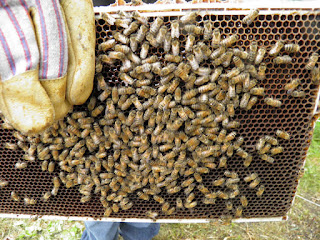Monday, June 25, 2012
A most welcomed rain began last night and continues intermittently this morning. It's an even 55° outside now, windless and quiet and the critters of the woods and skies are quiet too, apparently waiting for the storm to pass. We have been asking for rain for weeks now and although we still didn't get what we really need, the amount that has fallen so far has made farmers happy that the parched fields left from recent "first cuttings" have had a drink. Gail says the weather reports look like continued rain for three days. We'll see.
The picture up top here is of some hellebores I purchased from Barry Glick, Sunshine Farm and Gardens several years ago. Although they are going to seed right now, they were beautiful this spring and because of such limited snow cover this past winter, they bloomed earlier and longer than usual. Barry has been hybridzing this plant for many years and his website is worth a look-see for many reasons. He has a special going on now and I am thinking about purchasing another 150 plants to spread among the shade garden at the flower farm. Hellebores do great with sun but I have places were the sun pokes through the maples and box elders and that's where I am thinking for more spring and early summer color.
If you grow different hellebores, send along a note or some pictures so more gardeners can see what a nice plant this is. A bouquet of mixed colors is beautiful and brightens the house for some time.
Time to pack some lunch and head to the farm. Need to start by giving the zinnias a final weeding. Not fun work but it has to happen. If you are out and about today, stop and say hello. Gail and Michael will be there all day today. I'll be in and out.
George Africa
The Vermont Gardener
Vermont Flower Farm
On Facebook as Vermont Flower Farm and Gardens and also as George Africa
On Twitter as vtflowerfarm
Always here to help you grow your green thumb!
The picture up top here is of some hellebores I purchased from Barry Glick, Sunshine Farm and Gardens several years ago. Although they are going to seed right now, they were beautiful this spring and because of such limited snow cover this past winter, they bloomed earlier and longer than usual. Barry has been hybridzing this plant for many years and his website is worth a look-see for many reasons. He has a special going on now and I am thinking about purchasing another 150 plants to spread among the shade garden at the flower farm. Hellebores do great with sun but I have places were the sun pokes through the maples and box elders and that's where I am thinking for more spring and early summer color.
If you grow different hellebores, send along a note or some pictures so more gardeners can see what a nice plant this is. A bouquet of mixed colors is beautiful and brightens the house for some time.
Time to pack some lunch and head to the farm. Need to start by giving the zinnias a final weeding. Not fun work but it has to happen. If you are out and about today, stop and say hello. Gail and Michael will be there all day today. I'll be in and out.
George Africa
The Vermont Gardener
Vermont Flower Farm
On Facebook as Vermont Flower Farm and Gardens and also as George Africa
On Twitter as vtflowerfarm
Always here to help you grow your green thumb!

















































